Tuning Magnetic Properties of a Carbon Nanotube-Lanthanide Hybrid Molecular Complex through Controlled Functionalization
Abstract
1. Introduction
2. Results and Discussion
2.1. Raman Spectroscopy
2.2. Modification of Magnetic Properties of Functionalized MWNTs Loaded with Gd-DTPA Chelate Attachment of Gd-DTPA
2.3. SQUID Magnetometry
2.4. CNT Magnetic Property Tuning
3. Experimental
3.1. Functionalization of MWCNTs
3.2. Gd-DTPA Chelate Synthesis
3.3. CNT-Gd-DTPA Complex Synthesis
3.4. Characterization
4. Conclusions
Supplementary Materials
Author Contributions
Funding
Data Availability Statement
Acknowledgments
Conflicts of Interest
Sample Availability
References
- Iijima, S.; Ichihashi, T. Single-shell carbon nanotubes of 1-nm diameter. Nat. Cell Biol. 1993, 363, 603–605. [Google Scholar] [CrossRef]
- Dresselhaus, M.; Dresselhaus, G.; Saito, R. Physics of carbon nanotubes. Carbon 1995, 33, 883–891. [Google Scholar] [CrossRef]
- Rotkin, S.V.; Subramoney, S. (Eds.) Applied Physics of Carbon Nanotubes: Fundamentals of Theory, Optics and Transport Devices, 1st ed.; Springer: Berlin/Heidelberg, Germany, 2006; pp. 1–39. [Google Scholar]
- Urdampilleta, M.; Nguyen, N.-V.; Cleuziou, J.-P.; Klyatskaya, S.; Ruben, M.; Wernsdorfer, W. Molecular Quantum Spintronics: Supramolecular Spin Valves Based on Single-Molecule Magnets and Carbon Nanotubes. Int. J. Mol. Sci. 2011, 12, 6656–6667. [Google Scholar] [CrossRef] [PubMed]
- Balasubramanian, K.; Burghard, M. Chemically Functionalized Carbon Nanotubes. Small 2005, 1, 180–192. [Google Scholar] [CrossRef]
- Dresselhaus, M.S.; Dresselhaus, G.; Saito, R.; Jorio, A. Raman spectroscopy of carbon nanotubes. Phys. Rep. 2005, 409, 47–99. [Google Scholar] [CrossRef]
- Ferrari, A.C. Determination of bonding in diamond-like carbon by Raman spectroscopy. Diam. Relat. Mater. 2002, 11, 1053–1061. [Google Scholar] [CrossRef]
- Rebelo, S.L.H.; Guedes, A.; Szefczyk, M.E.; Pereira, A.M.; Araújo, J.P.; Freire, C. Progress in the Raman spectra analysis of covalently functionalized multiwalled carbon nanotubes: Unraveling disorder in graphitic materials. Phys. Chem. Chem. Phys. 2016, 18, 12784–12796. [Google Scholar] [CrossRef]
- Botti, S.; Rufoloni, A.; Rindzevicius, T.; Schmidt, M.S. Surface-Enhanced Raman Spectroscopy Characterization of Pristine and Functionalized Carbon Nanotubes and Graphene. In Raman Spectroscopy; IntechOpen: London, UK, 2018; pp. 203–219. [Google Scholar]
- Castiglioni, C.; Mapelli, C.; Negri, F.; Zerbi, G. Origin of the D line in the Raman spectrum of graphite: A study based on Raman frequencies and intensities of polycyclic aromatic hydrocarbon molecules. J. Chem. Phys. 2001, 114, 963. [Google Scholar] [CrossRef]
- Li, X.; Hayashi, J.-I.; Li, C.-Z. FT-Raman spectroscopic study of the evolution of char structure during the pyrolysis of a Victorian brown coal. Fuel 2006, 85, 1700–1707. [Google Scholar] [CrossRef]
- Shirakawa, H.; Ito, T.; Ikeda, S. Raman Scattering and Electronic Spectra of Poly(acetylene). Polym. J. 1973, 4, 460–462. [Google Scholar] [CrossRef]
- Buisson, J.; Mevellec, J.; Zeraoui, S.; Lefrant, S. Comparative study of the vibrational properties of polymers with phenyl ring. Synth. Met. 1991, 41, 287–290. [Google Scholar] [CrossRef]
- Baruya, A.; Gerrard, D.L.; Maddams, W.F. Resonance Raman spectrum of degraded poly(vinyl chloride). 4. Determination of conjugated polyene sequence lengths. Macromolecules 1983, 16, 578–580. [Google Scholar] [CrossRef]
- Lipińska, M.; Rebelo, S.; Pereira, M.; Gomes, J.; Freire, C.; Figueiredo, J. New insights into the functionalization of multi-walled carbon nanotubes with aniline derivatives. Carbon 2012, 50, 3280–3294. [Google Scholar] [CrossRef]
- Sadezky, A.; Muckenhuber, H.; Grothe, H.; Niessner, R.; Pöschl, U. Raman microspectroscopy of soot and related carbonaceous materials: Spectral analysis and structural information. Carbon 2005, 43, 1731–1742. [Google Scholar] [CrossRef]
- Zhou, W.; Sasaki, S.; Kawasaki, A. Effective control of nanodefects in multiwalled carbon nanotubes by acid treatment. Carbon 2014, 78, 121–129. [Google Scholar] [CrossRef]
- Chernyak, S.A.; Ivanov, A.S.; Maslakov, K.I.; Egorov, A.V.; Shen, Z.; Savilov, S.; Lunin, V.V. Oxidation, defunctionalization and catalyst life cycle of carbon nanotubes: A Raman spectroscopy view. Phys. Chem. Chem. Phys. 2017, 19, 2276–2285. [Google Scholar] [CrossRef]
- Xiao, D.; Dramou, P.; He, H.; Pham-Huy, L.A.; Li, H.; Yao, Y.; Pham-Huy, C. Magnetic carbon nanotubes: Synthesis by a simple solvothermal process and application in magnetic targeted drug delivery system. J. Nanoparticle Res. 2012, 14, 984. [Google Scholar] [CrossRef]
- Servant, A.; Jacobs, I.I.; Bussy, C.; Fabbro, C.; Da Ros, T.; Pach, E.; Ballesteros, B.; Prato, M.; Nicolay, K.; Kostarelos, K. Gadolinium-functionalised multi-walled carbon nanotubes as a T 1 contrast agent for MRI cell labelling and tracking. Carbon 2016, 97, 126–133. [Google Scholar] [CrossRef]
- Graupner, R. Raman spectroscopy of covalently functionalized single-wall carbon nanotubes. J. Raman Spectrosc. 2007, 38, 673–683. [Google Scholar] [CrossRef]
- Ferrari, A.C.; Robertson, J. Interpretation of Raman spectra of disordered and amorphous carbon. Phys. Rev. B 2000, 61, 14095–14107. [Google Scholar] [CrossRef]
- Wildman, A.P. The Influence of Oxalic Acid on Rates of Strong Chelate Exchange. Bachelor’s honors Thesis, Whitman College, Washington, DC, USA, 11 May 2016. [Google Scholar]
- Lipert, K.; Ritschel, M.; Leonhardt, A.; Krupskaya, Y.; Büchner, B.; Klingeler, R. Magnetic properties of carbon nanotubes with and without catalyst. J. Phys. Conf. Ser. 2010, 200, 1–4. [Google Scholar] [CrossRef]
- Kotosonov, A.; Kuvshinnikov, S. Diamagnetism of some quasi-two-dimensional graphites and multiwall carbon nanotubes. Phys. Lett. A 1997, 230, 377–380. [Google Scholar] [CrossRef]
- Tsui, F.; Jin, L.; Zhou, O. Anisotropic magnetic susceptibility of multiwalled carbon nanotubes. Appl. Phys. Lett. 2000, 76, 1452–1454. [Google Scholar] [CrossRef]
- Ajiki, H.; Ando, T. Aharonov-Bohm effect in carbon nanotubes. Phys. B Condens. Matter 1994, 201, 349–352. [Google Scholar] [CrossRef]
- Priour, D.J.; Hwang, E.H.; Das Sarma, S. Disordered RKKY Lattice Mean Field Theory for Ferromagnetism in Diluted Magnetic Semiconductors. Phys. Rev. Lett. 2004, 92, 117201. [Google Scholar] [CrossRef]
- Lamanna, G.; Garofalo, A.; Popa, G.; Wilhelm, C.; Bégin-Colin, S.; Felder-Flesch, D.; Bianco, A.; Gazeau, F.; Ménard-Moyon, C. Endowing carbon nanotubes with superparamagnetic properties: Applications for cell labeling, MRI cell tracking and magnetic manipulations. Nanoscale 2013, 5, 4412. [Google Scholar] [CrossRef] [PubMed]
- Sitharaman, B.; Kissell, K.R.; Hartman, K.B.; Tran, L.A.; Baikalov, A.; Rusakova, I.; Sun, Y.; Khant, H.A.; Ludtke, S.J.; Chiu, W.; et al. Superparamagnetic gadonanotubes are high-performance MRI contrast agents. Chem. Commun. 2005, 3915–3917. [Google Scholar] [CrossRef]
- Skomski, R.; Zhang, R.; Kharel, P.; Enders, A.; Liou, S.; Sellmyer, D.J. Magnetic susceptibility of nanoscale Kondo systems. J. Appl. Phys. 2010, 107, 09E126. [Google Scholar] [CrossRef]
- Desgranges, H.-U. Crystal fields and Kondo effect: New results for the magnetic susceptibility. Phys. B Condens. Matter 2015, 473, 93–100. [Google Scholar] [CrossRef][Green Version]
- Ncube, S.; Coleman, C.; Strydom, A.; Flahaut, E.; De Sousa, A.; Bhattacharyya, S. Kondo effect and enhanced magnetic properties in gadolinium functionalized carbon nanotube supramolecular complex. Sci. Rep. 2018, 8, 8057. [Google Scholar] [CrossRef]
- Ncube, S.; Coleman, C.; De Sousa, A.S.; Nie, C.; Lonchambon, P.; Flahaut, E.; Strydom, A.; Bhattacharyya, S. Observation of strong Kondo like features and co-tunnelling in superparamagnetic GdCl3 filled 1D nanomagnets. J. Appl. Phys. 2018, 123, 213901. [Google Scholar] [CrossRef]
- McIntosh, R.; Bhattacharyya, S. The Kondo effect in reduced graphene oxide films. Phys. Status Solidi (RRL) Rapid Res. Lett. 2011, 6, 56–58. [Google Scholar] [CrossRef]
- Albisetti, E.; Petti, D.; Sala, G.; Silvani, R.; Tacchi, S.; Finizio, S.; Wintz, S.; Calò, A.; Zheng, X.; Raabe, J.; et al. Nanoscale spin-wave circuits based on engineered reconfigurable spin-textures. Commun. Phys. 2018, 1, 56. [Google Scholar] [CrossRef]
- Cottet, A.; Feuillet-Palma, C.; Kontos, T. Multiterminal spin-dependent transport in ballistic carbon nanotubes. Phys. Rev. B 2009, 79, 125422. [Google Scholar] [CrossRef]
- Desjardins, M.M.; Contamin, L.C.; Delbecq, M.R.; Dartiailh, M.C.; Bruhat, L.E.; Cubaynes, T.; Viennot, J.J.; Mallet, F.; Rohart, S.; Thiaville, A.; et al. Synthetic spin–orbit interaction for Majorana devices. Nat. Mater. 2019, 18, 1060–1064. [Google Scholar] [CrossRef]
- Jun, L.Y.; Mubarak, N.M.; Yon, L.S.; Bing, C.H.; Khalid, M.; Abdullah, E. Comparative study of acid functionalization of carbon nanotube via ultrasonic and reflux mechanism. J. Environ. Chem. Eng. 2018, 6, 5889–5896. [Google Scholar] [CrossRef]
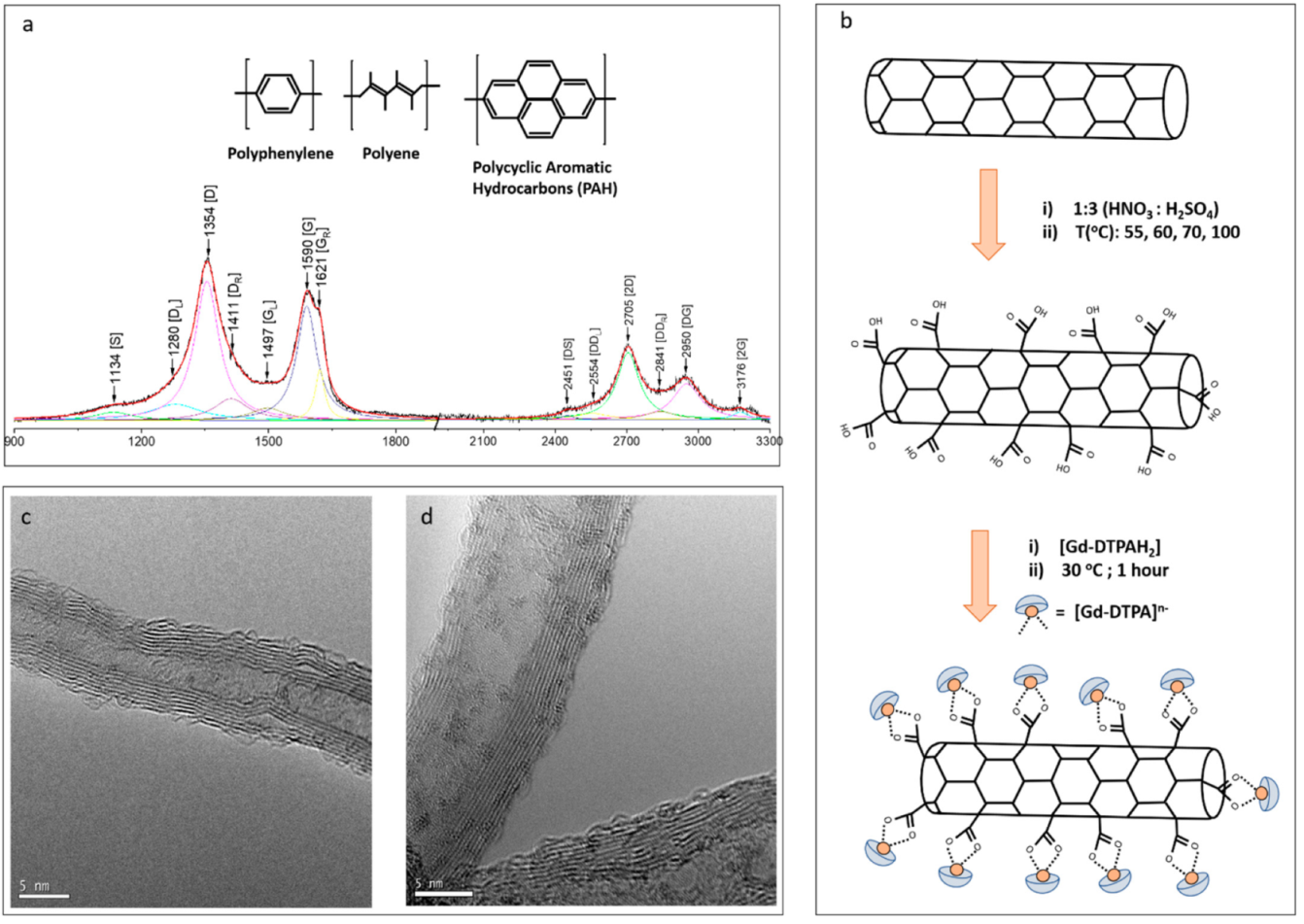
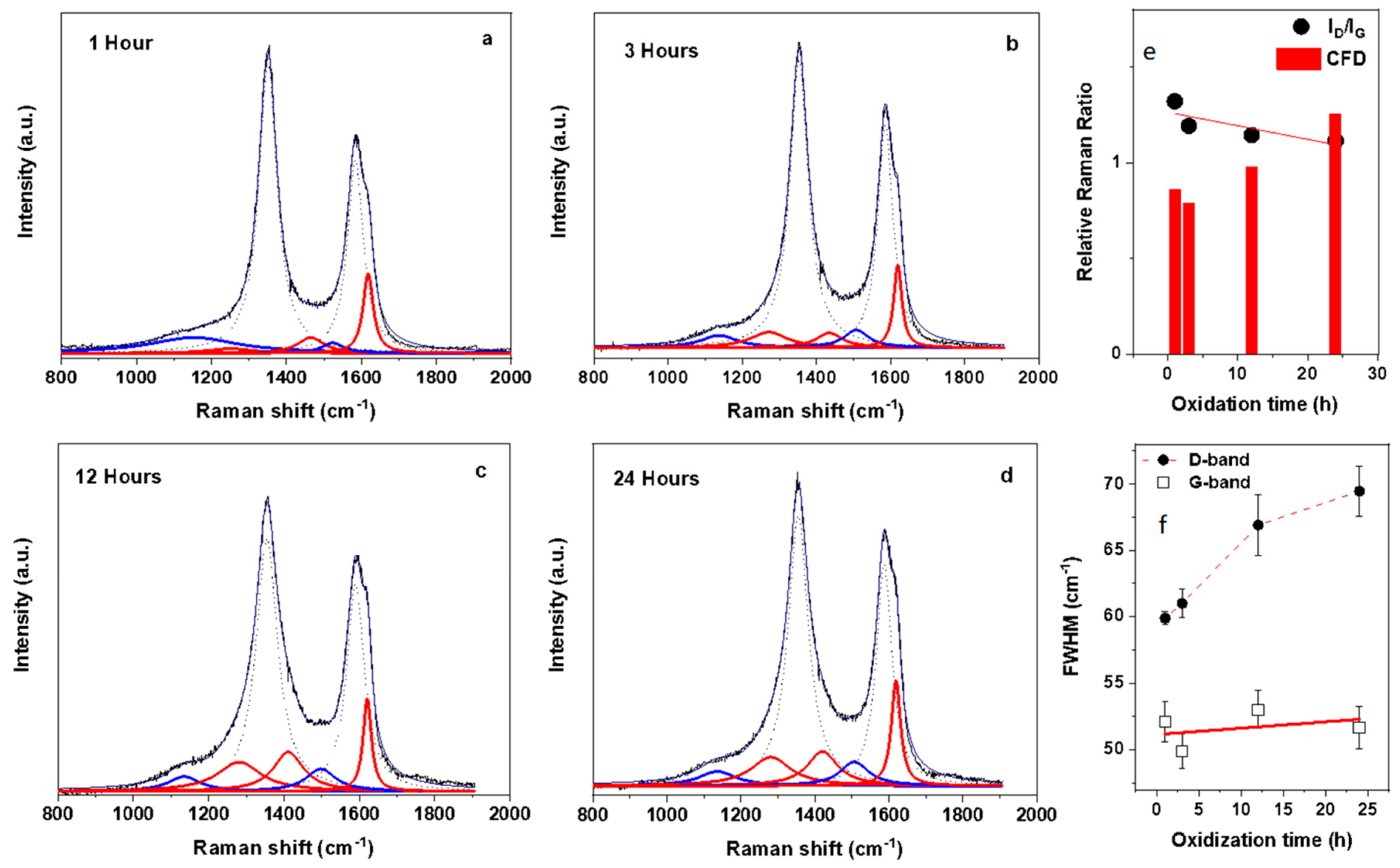

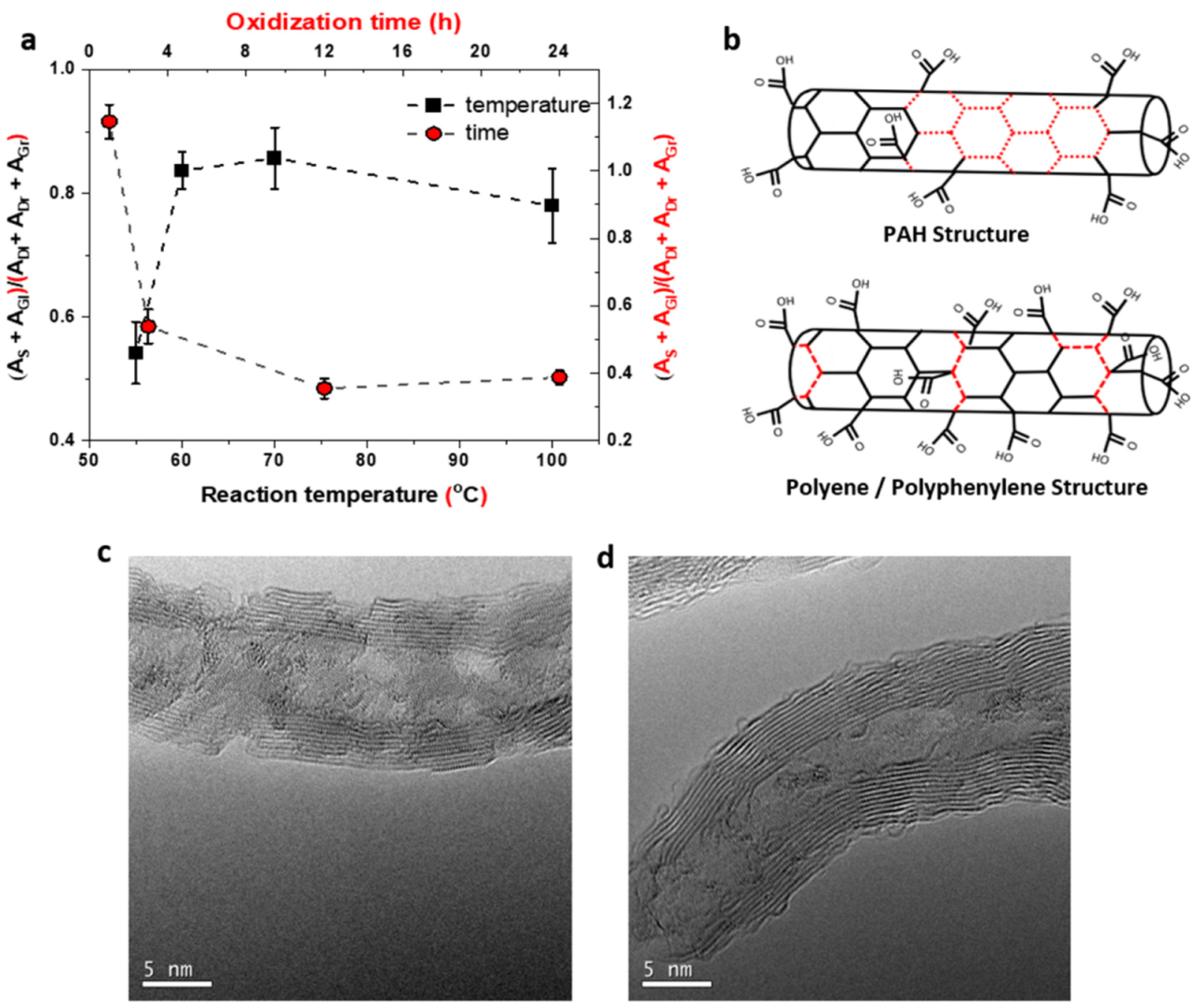

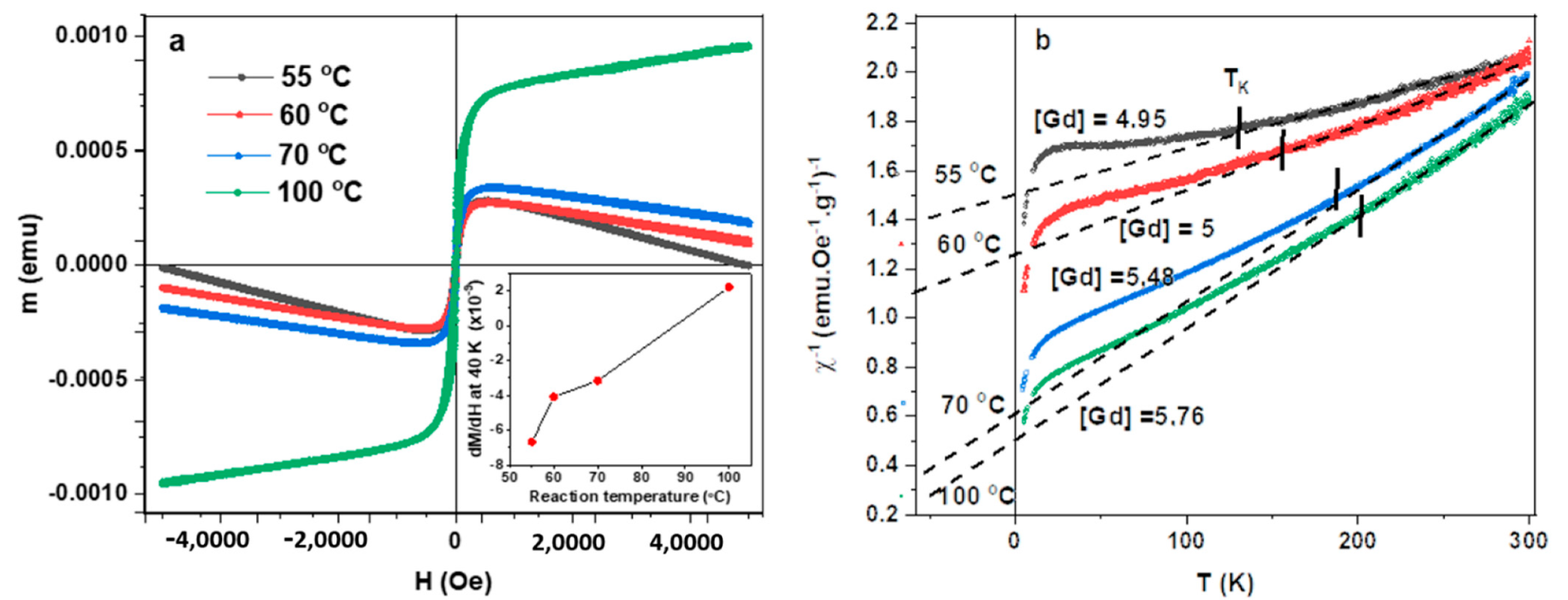
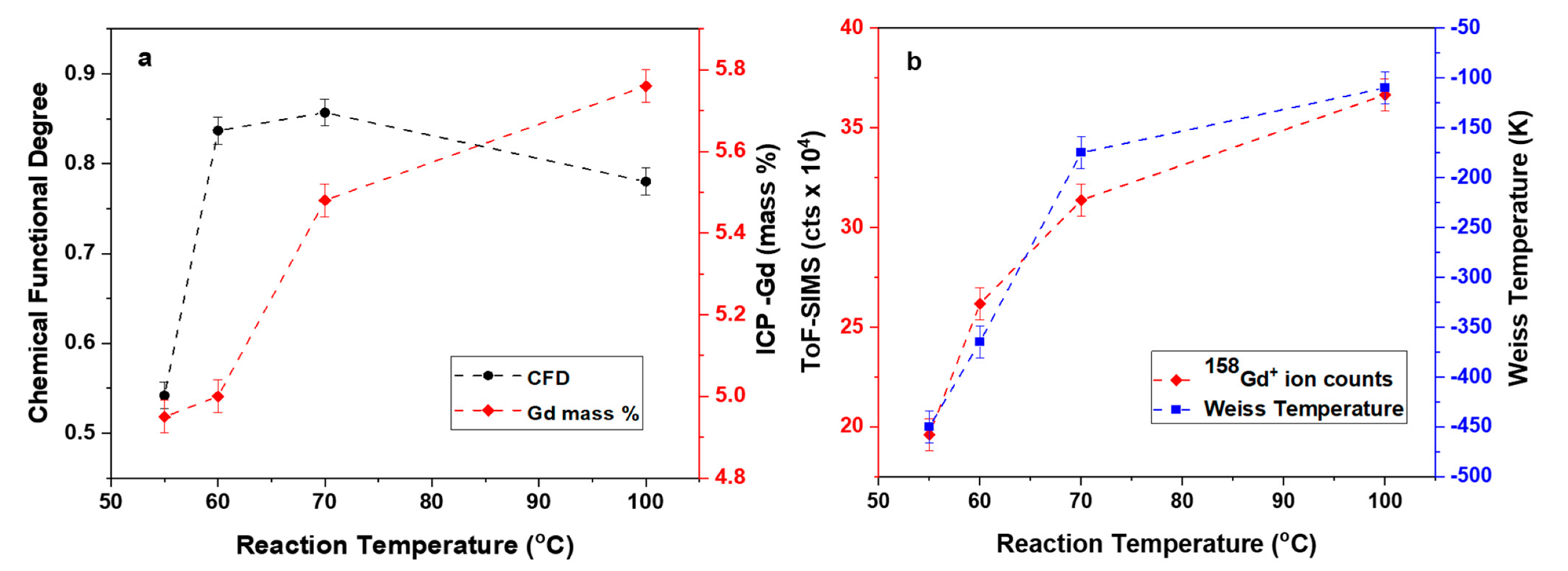
Publisher’s Note: MDPI stays neutral with regard to jurisdictional claims in published maps and institutional affiliations. |
© 2021 by the authors. Licensee MDPI, Basel, Switzerland. This article is an open access article distributed under the terms and conditions of the Creative Commons Attribution (CC BY) license (http://creativecommons.org/licenses/by/4.0/).
Share and Cite
Mosse, I.S.; Sodisetti, V.R.; Coleman, C.; Ncube, S.; de Sousa, A.S.; Erasmus, R.M.; Flahaut, E.; Blon, T.; Lassagne, B.; Šamořil, T.; et al. Tuning Magnetic Properties of a Carbon Nanotube-Lanthanide Hybrid Molecular Complex through Controlled Functionalization. Molecules 2021, 26, 563. https://doi.org/10.3390/molecules26030563
Mosse IS, Sodisetti VR, Coleman C, Ncube S, de Sousa AS, Erasmus RM, Flahaut E, Blon T, Lassagne B, Šamořil T, et al. Tuning Magnetic Properties of a Carbon Nanotube-Lanthanide Hybrid Molecular Complex through Controlled Functionalization. Molecules. 2021; 26(3):563. https://doi.org/10.3390/molecules26030563
Chicago/Turabian StyleMosse, Ibwanga S., Venkateswara Rao Sodisetti, Christopher Coleman, Siphephile Ncube, Alvaro S. de Sousa, Rudolph M. Erasmus, Emmanuel Flahaut, Thomas Blon, Benjamin Lassagne, Tomas Šamořil, and et al. 2021. "Tuning Magnetic Properties of a Carbon Nanotube-Lanthanide Hybrid Molecular Complex through Controlled Functionalization" Molecules 26, no. 3: 563. https://doi.org/10.3390/molecules26030563
APA StyleMosse, I. S., Sodisetti, V. R., Coleman, C., Ncube, S., de Sousa, A. S., Erasmus, R. M., Flahaut, E., Blon, T., Lassagne, B., Šamořil, T., & Bhattacharyya, S. (2021). Tuning Magnetic Properties of a Carbon Nanotube-Lanthanide Hybrid Molecular Complex through Controlled Functionalization. Molecules, 26(3), 563. https://doi.org/10.3390/molecules26030563








